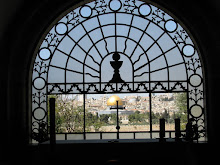Back to the desert….This time the Midrasha hike was towards South in the Negev, 60 km from campus. The region is close to the Israel-Egypt border; hence a strong military presence is observed always. From the mountain tops one can easily identify Israeli military installations with all its sophistications. Some parts of the route 171 (road to Lotz cisterns) are used by the Israel Defense Force (IDF) as fire practice area and hence closed to travelers (except for holidays). The trail was relatively short (10 km) took 9 hrs (including travel) and we were back by 4 pm. A brief description about the area…….
Borot Lotz
Borot Lotz is a collection of 17 unique water holes dating back to the Israelite period (1200-586 BC). The hiked trail also includes farming terraces, fruit orchards, threshing floors and old farmhouses. The farming settlement is dated from King Solomon's time, i.e. almost 3000 years ago. Evidences suggest that once wheat and barley were cultivated in these areas. In addition, frequent occurrence of large and tall standing stones in the valley indicates that some kind of pagan worship used to prevail here from ancient times. Today most of these ancient cisterns remain less impressive, filled with stones, mud and weeds. In winter the cisterns are filled with water and in spring the desert starts to bloom. However, this year due to irregular rainfall the region has not bloomed yet.
Nahal Elot
Elot is the Hebrew name for a tree called Pistacia. This valley and river basins are covered with hundreds of grand old Pistacia atlantia trees (some are even 800-1000 years old), the largest concentration of these species in Israel. Pistacia is the Biblical terebinths {some times translated Karuvelam (mal)}. The area is also rich with almond trees {Badam (Mal)}. We walked across this valley and climbed the Mount Elot or Rosh Elot (800 M). At the base of this mountain, standing stones are observed, reminding the ancient rituals once conducted here.
Mount Romem
Mt. Romem is one of the highest peaks (1020 M) in Negev. Upon its summit lie ancient ruins of pagan shrines and sanctuaries. But the most striking feature is a long line of stones (4.6 km) connecting this mountain with the adjacent Mt. Ramon (highest peak of Negev). These stretch of stones of semi-nomadic culture, dating back to the Bronze Age (1500-2500 BC) is known as the "K" line. However, no one still knows why K-line was built. Views from Mt Romem also include the mountain Arif-en-Nakaa, some believe as the real Mt. Sinai where God gave the Ten Commandments to Moses. However, it is just one among the 20 or more candidates speculated as Mt. Sinai.
See also
http://www.negevjeep.co.il/english/

No comments:
Post a Comment